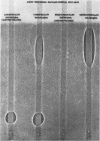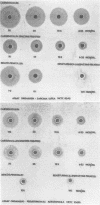Abstract
The assay of carbenicillin in clinical specimens is complicated by the fact that carbenicillin also contains a small amount of benzylpenicillin, thereby precluding the use of conventional penicillin assay organisms. This report gives details of a microbiological assay method involving the use of a strain of Pseudomonas aeruginosa which is very sensitive to carbenicillin but insensitive to benzylpenicillin. The outline of a microassay method with this organism is presented, and a method for the assay of specimens containing mixtures of carbenicillin and other antibiotics is described.
Full text
PDF



Images in this article
Selected References
These references are in PubMed. This may not be the complete list of references from this article.
- Acred P., Brown D. M., Knudsen E. T., Rolinson G. N., Sutherland R. New semi-synthetic penicillin active against Pseudomonas pyocyanea. Nature. 1967 Jul 1;215(5096):25–30. doi: 10.1038/215025a0. [DOI] [PubMed] [Google Scholar]
- Bodey G. P., Rodriguez V., Luce J. K. Carbenicillin therapy of gram-negative bacilli infections. Am J Med Sci. 1969 Jun;257(6):408–414. doi: 10.1097/00000441-196906000-00007. [DOI] [PubMed] [Google Scholar]
- Brumfitt W., Percival A., Leigh D. A. Clinical and laboratory studies with carbenicillin. A new penicillin active against Pseudomonas pyocyanea. Lancet. 1967 Jun 17;1(7503):1289–1293. doi: 10.1016/s0140-6736(67)91590-5. [DOI] [PubMed] [Google Scholar]
- Cole M., Sutherland R. The role of penicillin acylase in the resistance of gram-negative bacteria to penicillins. J Gen Microbiol. 1966 Mar;42(3):345–356. doi: 10.1099/00221287-42-3-345. [DOI] [PubMed] [Google Scholar]
- De Beer E. J., Sherwood M. B. The Paper-Disc Agar-Plate Method for the Assay of Antibiotic Substances. J Bacteriol. 1945 Oct;50(4):459–467. [PMC free article] [PubMed] [Google Scholar]
- Knudsen E. T., Rolinson G. N., Sutherland R. Carbenicillin: a new semisynthetic penicillin active against Pseudomonas pyocyanea. Br Med J. 1967 Jul 8;3(5557):75–78. doi: 10.1136/bmj.3.5557.75. [DOI] [PMC free article] [PubMed] [Google Scholar]
- Rolinson G. N., Sutherland R. Carbenicillin, a new semisynthetic penicillin active against Pseudomonas aeruginosa. Antimicrob Agents Chemother (Bethesda) 1967;7:609–613. [PubMed] [Google Scholar]
- Sabath L. D., Estey V. J., Finland M. Independent measurement of ampicillin and cloxacillin in mixtures. Appl Microbiol. 1967 May;15(3):468–470. doi: 10.1128/am.15.3.468-470.1967. [DOI] [PMC free article] [PubMed] [Google Scholar]
- Sabath L. D., Loder P. B., Gerstein D. A., Finland M. Measurement of three antibiotics (penicillin, cephalothin, and chloramphenicol) when present together in mixtures. Appl Microbiol. 1968 Jun;16(6):877–880. doi: 10.1128/am.16.6.877-880.1968. [DOI] [PMC free article] [PubMed] [Google Scholar]
- Standiford H. C., Kind A. C., Kirby W. M. Laboratory and clinical studies of carbenicillin against gram-negative bacilli. Antimicrob Agents Chemother (Bethesda) 1968;8:286–291. [PubMed] [Google Scholar]




